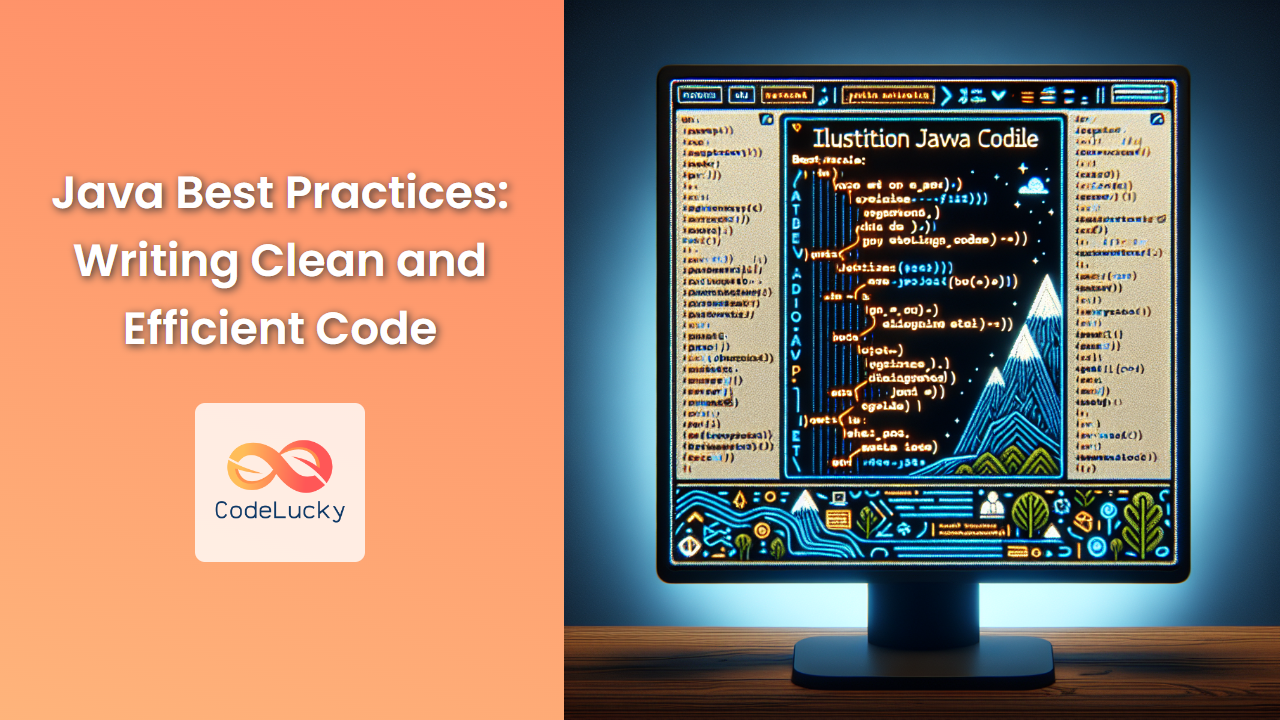Java, one of the most popular programming languages, offers developers a robust platform for building a wide range of applications. However, writing clean and efficient Java code requires more than just knowing the syntax. It demands adherence to best practices that enhance readability, maintainability, and performance. In this comprehensive guide, we'll explore essential Java best practices that will elevate your coding skills and help you create high-quality software.
1. Follow Naming Conventions
Proper naming conventions are crucial for code readability and maintainability. Java has well-established naming conventions that you should follow:
- 🔤 Classes: Use PascalCase (e.g.,
CustomerService) - 🔤 Methods and variables: Use camelCase (e.g.,
calculateTotal(),firstName) - 🔤 Constants: Use UPPER_SNAKE_CASE (e.g.,
MAX_SIZE) - 🔤 Packages: Use lowercase, with dots as separators (e.g.,
com.company.project)
Let's look at an example that demonstrates these conventions:
package com.codelucky.bestpractices;
public class UserManager {
private static final int MAX_USERS = 100;
private String firstName;
private String lastName;
public String getFullName() {
return firstName + " " + lastName;
}
public void setUserDetails(String firstName, String lastName) {
this.firstName = firstName;
this.lastName = lastName;
}
}
In this example, we can see how the class name (UserManager), method names (getFullName, setUserDetails), variables (firstName, lastName), and constant (MAX_USERS) all follow the appropriate naming conventions.
2. Use Meaningful Names
While following naming conventions is important, it's equally crucial to choose names that are descriptive and meaningful. Good names should clearly convey the purpose or functionality of the element they represent.
❌ Bad example:
public class X {
private int a;
private String b;
public void doStuff() {
// Some code here
}
}
✅ Good example:
public class Employee {
private int id;
private String name;
public void calculateSalary() {
// Salary calculation logic here
}
}
In the good example, it's immediately clear what the class represents and what the method does, making the code much more readable and self-documenting.
3. Keep Methods Short and Focused
Methods should be concise and focused on a single task. This principle, known as the Single Responsibility Principle, makes code easier to understand, test, and maintain.
❌ Bad example:
public void processOrder(Order order) {
// Validate order
if (order.getItems().isEmpty()) {
throw new IllegalArgumentException("Order must have at least one item");
}
// Calculate total
double total = 0;
for (Item item : order.getItems()) {
total += item.getPrice() * item.getQuantity();
}
// Apply discount
if (total > 100) {
total *= 0.9; // 10% discount
}
// Update inventory
for (Item item : order.getItems()) {
Inventory.decreaseStock(item.getId(), item.getQuantity());
}
// Save order
Database.saveOrder(order);
// Send confirmation email
EmailService.sendOrderConfirmation(order.getCustomerEmail(), order.getId(), total);
}
✅ Good example:
public void processOrder(Order order) {
validateOrder(order);
double total = calculateTotal(order);
total = applyDiscount(total);
updateInventory(order);
saveOrder(order);
sendConfirmationEmail(order, total);
}
private void validateOrder(Order order) {
if (order.getItems().isEmpty()) {
throw new IllegalArgumentException("Order must have at least one item");
}
}
private double calculateTotal(Order order) {
return order.getItems().stream()
.mapToDouble(item -> item.getPrice() * item.getQuantity())
.sum();
}
private double applyDiscount(double total) {
return total > 100 ? total * 0.9 : total;
}
private void updateInventory(Order order) {
order.getItems().forEach(item ->
Inventory.decreaseStock(item.getId(), item.getQuantity()));
}
private void saveOrder(Order order) {
Database.saveOrder(order);
}
private void sendConfirmationEmail(Order order, double total) {
EmailService.sendOrderConfirmation(order.getCustomerEmail(), order.getId(), total);
}
In the good example, the processOrder method is broken down into smaller, more focused methods. This makes the code more readable and easier to maintain. Each method has a clear purpose and can be tested independently.
4. Use Appropriate Data Structures
Choosing the right data structure can significantly impact your code's performance and readability. Java provides a rich set of collections in the java.util package, each with its own strengths and use cases.
Here's a quick guide to help you choose:
| Data Structure | When to Use |
|---|---|
| ArrayList | For dynamic arrays with fast iteration and access by index |
| LinkedList | For frequent insertions and deletions at both ends |
| HashSet | For storing unique elements with no particular order |
| TreeSet | For storing unique elements in sorted order |
| HashMap | For key-value pairs with fast lookup |
| TreeMap | For key-value pairs in sorted order of keys |
Let's look at an example that demonstrates the use of appropriate data structures:
import java.util.*;
public class StudentManager {
private List<Student> studentList = new ArrayList<>();
private Set<String> uniqueStudentIds = new HashSet<>();
private Map<String, Student> studentMap = new HashMap<>();
public void addStudent(Student student) {
if (uniqueStudentIds.add(student.getId())) {
studentList.add(student);
studentMap.put(student.getId(), student);
} else {
throw new IllegalArgumentException("Student ID already exists");
}
}
public Student getStudentById(String id) {
return studentMap.get(id);
}
public List<Student> getAllStudents() {
return new ArrayList<>(studentList);
}
}
class Student {
private String id;
private String name;
// Constructor, getters, and setters
}
In this example:
- We use an
ArrayListto maintain the order of students and allow fast iteration. - A
HashSetis used to ensure unique student IDs efficiently. - A
HashMapprovides fast lookup of students by their ID.
This combination of data structures allows for efficient operations while maintaining the integrity of the data.
5. Handle Exceptions Properly
Proper exception handling is crucial for creating robust and reliable Java applications. Here are some best practices:
- 🛡️ Use specific exceptions instead of generic ones.
- 🛡️ Catch exceptions as close to the source as possible.
- 🛡️ Don't catch exceptions you can't handle.
- 🛡️ Always include a message with your exceptions.
- 🛡️ Use try-with-resources for automatic resource management.
Let's look at an example that demonstrates these practices:
import java.io.*;
import java.sql.*;
public class DataProcessor {
public void processData(String filePath) {
try (BufferedReader reader = new BufferedReader(new FileReader(filePath))) {
String line;
while ((line = reader.readLine()) != null) {
try {
processLine(line);
} catch (InvalidDataException e) {
System.err.println("Skipping invalid line: " + e.getMessage());
}
}
} catch (FileNotFoundException e) {
throw new ProcessingException("File not found: " + filePath, e);
} catch (IOException e) {
throw new ProcessingException("Error reading file: " + filePath, e);
}
}
private void processLine(String line) throws InvalidDataException {
// Process the line, throw InvalidDataException if data is invalid
}
public void saveToDatabase(String data) throws SQLException {
try (Connection conn = DriverManager.getConnection("jdbc:mysql://localhost/mydb", "user", "password");
PreparedStatement stmt = conn.prepareStatement("INSERT INTO mytable (data) VALUES (?)")) {
stmt.setString(1, data);
stmt.executeUpdate();
}
}
}
class InvalidDataException extends Exception {
public InvalidDataException(String message) {
super(message);
}
}
class ProcessingException extends RuntimeException {
public ProcessingException(String message, Throwable cause) {
super(message, cause);
}
}
In this example:
- We use specific exceptions (
FileNotFoundException,IOException,InvalidDataException,SQLException) instead of catching genericException. - Exceptions are caught and handled at appropriate levels.
- We include informative messages with our custom exceptions.
- The try-with-resources statement is used to automatically close the
BufferedReaderand database resources.
6. Use Streams and Lambdas for Cleaner Code
Java 8 introduced streams and lambda expressions, which can make your code more concise and readable, especially when working with collections. Here's an example that demonstrates their use:
import java.util.*;
import java.util.stream.*;
public class OrderProcessor {
private List<Order> orders;
public OrderProcessor(List<Order> orders) {
this.orders = orders;
}
public double getTotalRevenue() {
return orders.stream()
.mapToDouble(Order::getTotal)
.sum();
}
public List<String> getHighValueCustomers() {
return orders.stream()
.filter(order -> order.getTotal() > 1000)
.map(Order::getCustomerName)
.distinct()
.sorted()
.collect(Collectors.toList());
}
public Map<String, Double> getRevenueByProduct() {
return orders.stream()
.flatMap(order -> order.getItems().stream())
.collect(Collectors.groupingBy(
OrderItem::getProductName,
Collectors.summingDouble(item -> item.getPrice() * item.getQuantity())
));
}
}
class Order {
private String customerName;
private List<OrderItem> items;
// Constructor, getters, and setters
public double getTotal() {
return items.stream()
.mapToDouble(item -> item.getPrice() * item.getQuantity())
.sum();
}
}
class OrderItem {
private String productName;
private double price;
private int quantity;
// Constructor, getters, and setters
}
In this example:
getTotalRevenue()uses streams to calculate the sum of all order totals.getHighValueCustomers()filters high-value orders, extracts customer names, removes duplicates, sorts them, and collects the result into a list.getRevenueByProduct()uses flatMap to process all order items, then groups them by product name and sums the revenue for each product.
These stream operations replace what would otherwise be multiple loops and temporary collections, resulting in more concise and readable code.
7. Use Immutable Objects When Possible
Immutable objects are objects whose state cannot be changed after they are created. They are inherently thread-safe and can help prevent bugs caused by unexpected state changes. Here's an example of how to create an immutable class in Java:
import java.util.*;
public final class ImmutablePerson {
private final String name;
private final int age;
private final List<String> hobbies;
public ImmutablePerson(String name, int age, List<String> hobbies) {
this.name = name;
this.age = age;
this.hobbies = new ArrayList<>(hobbies); // Defensive copy
}
public String getName() {
return name;
}
public int getAge() {
return age;
}
public List<String> getHobbies() {
return Collections.unmodifiableList(hobbies);
}
@Override
public String toString() {
return "ImmutablePerson{" +
"name='" + name + '\'' +
", age=" + age +
", hobbies=" + hobbies +
'}';
}
}
Key points about this immutable class:
- The class is declared as
finalto prevent inheritance. - All fields are
privateandfinal. - There are no setter methods.
- The constructor makes a defensive copy of the mutable
Listargument. - The
getHobbies()method returns an unmodifiable view of the hobbies list.
Using this immutable class:
List<String> hobbies = new ArrayList<>(Arrays.asList("Reading", "Hiking"));
ImmutablePerson person = new ImmutablePerson("Alice", 30, hobbies);
System.out.println(person); // ImmutablePerson{name='Alice', age=30, hobbies=[Reading, Hiking]}
// Attempting to modify the original list doesn't affect the ImmutablePerson object
hobbies.add("Swimming");
System.out.println(person); // Still ImmutablePerson{name='Alice', age=30, hobbies=[Reading, Hiking]}
// Attempting to modify the list returned by getHobbies() throws an exception
try {
person.getHobbies().add("Swimming");
} catch (UnsupportedOperationException e) {
System.out.println("Cannot modify hobbies list: " + e.getMessage());
}
8. Use Enums for Fixed Sets of Constants
Enums in Java are more powerful than simple constants. They provide type-safety, can have methods, and can be used in switch statements. Here's an example of how to use enums effectively:
public class PayrollSystem {
public enum PaymentMethod {
DIRECT_DEPOSIT {
@Override
public void processPayment(Employee employee, double amount) {
System.out.println("Processing direct deposit of $" + amount + " for " + employee.getName());
// Logic for direct deposit
}
},
CHECK {
@Override
public void processPayment(Employee employee, double amount) {
System.out.println("Issuing check of $" + amount + " for " + employee.getName());
// Logic for issuing a check
}
},
CASH {
@Override
public void processPayment(Employee employee, double amount) {
System.out.println("Preparing cash payment of $" + amount + " for " + employee.getName());
// Logic for cash payment
}
};
public abstract void processPayment(Employee employee, double amount);
}
public void payEmployee(Employee employee, double amount, PaymentMethod method) {
method.processPayment(employee, amount);
}
}
class Employee {
private String name;
private PayrollSystem.PaymentMethod preferredMethod;
// Constructor, getters, and setters
public String getName() {
return name;
}
}
Using this enum:
PayrollSystem payrollSystem = new PayrollSystem();
Employee alice = new Employee("Alice", PayrollSystem.PaymentMethod.DIRECT_DEPOSIT);
Employee bob = new Employee("Bob", PayrollSystem.PaymentMethod.CHECK);
payrollSystem.payEmployee(alice, 5000, alice.getPreferredMethod());
payrollSystem.payEmployee(bob, 4500, bob.getPreferredMethod());
Output:
Processing direct deposit of $5000.0 for Alice
Issuing check of $4500.0 for Bob
This enum-based approach provides a clean, type-safe way to handle different payment methods, with each method encapsulating its own processing logic.
9. Use Builder Pattern for Complex Object Creation
When you have objects with many parameters, especially when some are optional, the Builder pattern can make object creation more readable and flexible. Here's an example:
public class Car {
private final String make;
private final String model;
private final int year;
private final String color;
private final int horsepower;
private final boolean isElectric;
private Car(Builder builder) {
this.make = builder.make;
this.model = builder.model;
this.year = builder.year;
this.color = builder.color;
this.horsepower = builder.horsepower;
this.isElectric = builder.isElectric;
}
public static class Builder {
private final String make;
private final String model;
private final int year;
private String color = "White"; // Default value
private int horsepower = 100; // Default value
private boolean isElectric = false; // Default value
public Builder(String make, String model, int year) {
this.make = make;
this.model = model;
this.year = year;
}
public Builder color(String color) {
this.color = color;
return this;
}
public Builder horsepower(int horsepower) {
this.horsepower = horsepower;
return this;
}
public Builder electric(boolean isElectric) {
this.isElectric = isElectric;
return this;
}
public Car build() {
return new Car(this);
}
}
@Override
public String toString() {
return "Car{" +
"make='" + make + '\'' +
", model='" + model + '\'' +
", year=" + year +
", color='" + color + '\'' +
", horsepower=" + horsepower +
", isElectric=" + isElectric +
'}';
}
}
Using the Builder pattern:
Car car1 = new Car.Builder("Toyota", "Camry", 2022)
.color("Red")
.horsepower(203)
.build();
Car car2 = new Car.Builder("Tesla", "Model 3", 2023)
.color("Blue")
.horsepower(283)
.electric(true)
.build();
System.out.println(car1);
System.out.println(car2);
Output:
Car{make='Toyota', model='Camry', year=2022, color='Red', horsepower=203, isElectric=false}
Car{make='Tesla', model='Model 3', year=2023, color='Blue', horsepower=283, isElectric=true}
The Builder pattern allows for a more flexible and readable way of creating objects, especially when there are many parameters or when some parameters are optional.
10. Use Interface-Based Programming
Programming to interfaces rather than concrete implementations promotes loose coupling and makes your code more flexible and easier to maintain. Here's an example:
public interface PaymentGateway {
void processPayment(double amount);
boolean refundPayment(String transactionId, double amount);
}
public class PayPalGateway implements PaymentGateway {
@Override
public void processPayment(double amount) {
System.out.println("Processing PayPal payment of $" + amount);
// PayPal-specific payment processing logic
}
@Override
public boolean refundPayment(String transactionId, double amount) {
System.out.println("Refunding PayPal payment of $" + amount + " for transaction " + transactionId);
// PayPal-specific refund logic
return true;
}
}
public class StripeGateway implements PaymentGateway {
@Override
public void processPayment(double amount) {
System.out.println("Processing Stripe payment of $" + amount);
// Stripe-specific payment processing logic
}
@Override
public boolean refundPayment(String transactionId, double amount) {
System.out.println("Refunding Stripe payment of $" + amount + " for transaction " + transactionId);
// Stripe-specific refund logic
return true;
}
}
public class PaymentProcessor {
private PaymentGateway gateway;
public PaymentProcessor(PaymentGateway gateway) {
this.gateway = gateway;
}
public void makePayment(double amount) {
gateway.processPayment(amount);
}
public boolean refund(String transactionId, double amount) {
return gateway.refundPayment(transactionId, amount);
}
}
Using interface-based programming:
PaymentGateway paypalGateway = new PayPalGateway();
PaymentGateway stripeGateway = new StripeGateway();
PaymentProcessor paypalProcessor = new PaymentProcessor(paypalGateway);
PaymentProcessor stripeProcessor = new PaymentProcessor(stripeGateway);
paypalProcessor.makePayment(100.0);
stripeProcessor.makePayment(200.0);
paypalProcessor.refund("TX123", 50.0);
stripeProcessor.refund("TX456", 75.0);
Output:
Processing PayPal payment of $100.0
Processing Stripe payment of $200.0
Refunding PayPal payment of $50.0 for transaction TX123
Refunding Stripe payment of $75.0 for transaction TX456
By programming to the PaymentGateway interface, the PaymentProcessor class is decoupled from specific payment gateway implementations. This makes it easy to add new payment gateways or switch between them without changing the PaymentProcessor code.
Conclusion
Adopting these Java best practices will significantly improve the quality of your code. Clean, efficient code is easier to read, maintain, and extend. It leads to fewer bugs and a more enjoyable development experience. Remember, writing good code is a skill that improves with practice. Continuously refine your coding habits, stay updated with the latest Java features, and always strive to write code that is not just functional, but also clean and efficient.
By following these best practices, you'll be well on your way to becoming a more proficient Java developer, capable of creating robust, maintainable, and high-performance applications. Happy coding! 🚀👨💻👩💻
- 1. Follow Naming Conventions
- 2. Use Meaningful Names
- 3. Keep Methods Short and Focused
- 4. Use Appropriate Data Structures
- 5. Handle Exceptions Properly
- 6. Use Streams and Lambdas for Cleaner Code
- 7. Use Immutable Objects When Possible
- 8. Use Enums for Fixed Sets of Constants
- 9. Use Builder Pattern for Complex Object Creation
- 10. Use Interface-Based Programming
- Conclusion



















